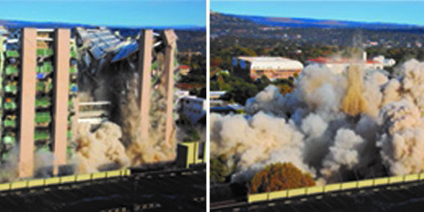Demolition Day

Demolition Day
There are only a few topics I’m qualified to speak about, but architectural remodeling is one of them. As the son of a realtor who owned rent houses — a special kind of Hell I could write an entire book about — I grew up repairing the damage renters had inflicted on those structures. Consequently, when I watch those goofy house-flipping shows on home improvement channels, I sometimes vomit.
One facet of those shows that always sets my teeth grinding is the concept of “demolition day”. It plays right into a particularly human character flaw, but I’ll get to that later. The actors — and they are just actors — express giddy delight in violently ripping out old cabinets, sledgehammering down walls, and destroying outdated architectural accessories. So much for recycling.
Due to the skillset, I developed through my father’s misguided landlord dreams, I’ve supervised several significant remodeling projects — both residential and commercial. In the beginning, everybody is upbeat and ready to get rid of the “old” to make way for the “new”. But it’s kind of like a kid peeling away the scab of a skinned knee, expecting to reveal fresh pink skin, only to cause more bleeding, more pain, and an ugly scar. (Don’t even pretend you never did that.)
Ripping away the moldy, paint-peeling sheet rock, promises the discovery of pristinely preserved wall studs awaiting a quick new re-covering and fresh paint. What it more commonly accomplishes is the discovery of hidden damage along with a realization of how extensive the project will really become. In every project, that’s the point where disillusioned volunteers fall away, costs soar, and arson becomes a viable alternative. Only an appreciation for the structure’s genuine value prevents that toasty shortcut.
The Real Cost of Demolition
While run-down and outdated materials do need to be replaced, the danger lies in damaging the underlying structure, possibly even beyond repair. On a church building I helped renovate several years ago, the entire 40’ by 85’ peer-and-beam floor was rotted and required replacement. Before the floor could be removed, we spent weeks bracing the outside walls lest they fall when the old floor was detached.
A similar danger existed when we began removing rotted sections of the roof and rafters. A single poorly planned move and several tons of old roof could have crashed down on the volunteers.
Cultural Deconstruction
For some reason, Americans love nothing more than to see the mighty fall. We rejoice when famous pastors get caught in their sins, when Hollywood celebrities commit suicide over the meaninglessness of their riches, and when politicians finally get outed for their corruption.
I once read an editorial comparing the dethroned Lance Armstrong to Atilla the Hun. It did not escape my notice that the same journalist had, only a year earlier, praised Mr. Armstrong for “putting those smug French in their place”. The media must have been practically orgasmic back on Black Thursday as they reported on titans of industry leaping to their deaths from skyscrapers.
Apart from the media, today’s self-appointed gurus seem to be university professors who revel in deconstructing the philosophical foundations of their young students. Never mind that those professors’ tenured positions insulate them from the honest competition of the real-world job market. They seem to have deemed themselves worthy of destroying the psyches of those who are, in fact, funding their coddled lifestyles.
Unquestionably, our beliefs should be subject to introspection and critical self-assessment. I know of few serious thinkers who have not entered the deep dark cave of self-doubt and redirection — some for extended periods. But just like the volunteers who understood the historic value of that old church building and recognized the need for pre-demolition bracing, we need communicators who comprehend the intrinsic value of their audience before engaging in the sort of deconstruction that brings the walls down.
I’m not advocating the banning of politically incorrect trigger points. I’m talking about the opposite — vigorous debate while respecting the validity of competing perspectives. I’m talking about resisting the overwhelming desire to wear the robe of God’s prophet. I’m talking about rethinking the urge to tear down anything that is not new and shiny. I’m talking about appreciating the value of philosophies and systems that have withstood the test of time far longer than their detractors have been on Earth.
Maybe you see holes in that concept. Great! Email me and I’ll buy you coffee just to hear your thoughts … without any attempt to deconstruct your worldview.
 Let’s talk. I’d really like to hear what you have to say, and it might even give me something to write about. Email me at guy@lawsoncomm.com.
Let’s talk. I’d really like to hear what you have to say, and it might even give me something to write about. Email me at guy@lawsoncomm.com.
I’ll buy you coffee and we can compare notes. I promise not to steal your ideas without permission.
![]()
The anvil is not afraid of the hammer.
— Charles Spurgeon


Did someone forward this newsletter to you after reading it themselves? Don’t settle for that!
CLICK HERE
to get a fresh, unused copy of this newsletter sent directly to you every Sunday morning. If you decide it stinks, you can always unsubscribe.

How the West Won
— Rodney Stark
Ever wonder how Western thought triumphed over all the competing philosophies? Stark is a master at weaving history, sociology, and even geography, into a narrative that makes sense of how we got to where we are today. Given the constant harping about the evils of Capitalism and Western civilization, it’s refreshing to encounter a more even-handed treatment of the evolution from the jungles to the suburbs.
A meeting of great minds who think alike












